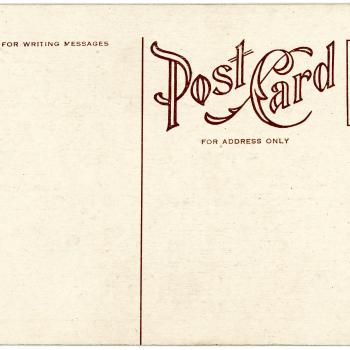Book Report Alternative: Creating Postcards for Fictional Settings

- Preview |
- Standards |
- Resources & Preparation |
- Instructional Plan |
- Related Resources |
- Comments
Overview
The setting of a book can transport the reader to a time long ago such as prehistoric Earth or a place far away such as the planet Jupiter. It may transport the reader to a new world in the future reached only through one's imagination. Though a critical part of any tale, the setting does not necesasrily lend itself to student creativity when reporting in the traditional format of a book report. In this lesson students are given the opportunity to be imaginative as they create illustrated postcards that depict the one of the settings of their novel choices featuring journeys. Furthermore, they communicate about the importance of the settings as they write the text of their postcards.
Featured Resources
Postcard Creator: This student interactive will illustrate the parts of a postcard.
Recording the Setting Bookmark: Students will use this bookmark as they read their novels to record facts about the multiple settings of their books.
What Will I Read Next? Students will use this printout as they listen to each others’ reports to keep track of books they wish to remember for reading later.
From Theory to Practice
In 1998, Mitchell stated that “students tire of responding to novels in the same ways.” In 2005 Voukon pointed out, “the tried and true one-size-fits-all conflict-action-climax book report” does not create excitement for reading. The opinions of these authors are still valuable when considering today’s students who are accustomed to images accompanying explanations. Therefore, this lesson transforms the simple reporting of when and where a novel takes place into an engaging activity that includes images and text.
Common Core Standards
This resource has been aligned to the Common Core State Standards for states in which they have been adopted. If a state does not appear in the drop-down, CCSS alignments are forthcoming.
State Standards
This lesson has been aligned to standards in the following states. If a state does not appear in the drop-down, standard alignments are not currently available for that state.
NCTE/IRA National Standards for the English Language Arts
- 1. Students read a wide range of print and nonprint texts to build an understanding of texts, of themselves, and of the cultures of the United States and the world; to acquire new information; to respond to the needs and demands of society and the workplace; and for personal fulfillment. Among these texts are fiction and nonfiction, classic and contemporary works.
- 2. Students read a wide range of literature from many periods in many genres to build an understanding of the many dimensions (e.g., philosophical, ethical, aesthetic) of human experience.
- 3. Students apply a wide range of strategies to comprehend, interpret, evaluate, and appreciate texts. They draw on their prior experience, their interactions with other readers and writers, their knowledge of word meaning and of other texts, their word identification strategies, and their understanding of textual features (e.g., sound-letter correspondence, sentence structure, context, graphics).
- 4. Students adjust their use of spoken, written, and visual language (e.g., conventions, style, vocabulary) to communicate effectively with a variety of audiences and for different purposes.
- 5. Students employ a wide range of strategies as they write and use different writing process elements appropriately to communicate with different audiences for a variety of purposes.
- 6. Students apply knowledge of language structure, language conventions (e.g., spelling and punctuation), media techniques, figurative language, and genre to create, critique, and discuss print and nonprint texts.
Materials and Technology
- Classroom with LCD projector and whiteboard/interactive whiteboard
- Novels for the students—either from the school library or the classroom library
- Computers with printing and Internet capabilities
- Poster board and markers if students will draw their own postcards
Printouts
Websites
This webpage inspired this lesson. It displays postcards from movie settings, some of which were books first. This page will be used to introduce students to the idea of creating postcards from book settings.
Preparation
- Make one copy for each student of the printouts What Will I Read Next?, and Postcard Setting Rubric. Make one copy for every three students of the printout Recording the Setting Bookmark as this printout has three bookmarks per sheet.
- Reserve time for using computers during Session Two to access the Postcard Creator.
- Decide which method students will use to create their postcards, or you might want the students to make this choice:
- If students will use poster board and markers, secure these items for your classroom.
- If students will use computer word processing program such as Microsoft Word templates, reserve time for computers.
- Gather sample postcards to share with the class in Session One.
- Use the printout Novels Featuring Journeys to gather books for students to make their selections. Also, discuss with your school librarian other possible titles that feature journeys.
Student Objectives
Students will
- understand the literary term setting.
- identify an important setting of a particular novel.
- create a postcard that illustrates this setting.
Session One: Introducing the Project
- Ask students about their experiences in traveling.
- Ask where they have gone.
- Ask if they took any pictures.
- Ask if they kept in contact with friends and family back home.
- Show sample postcards you have collected for this session.
- Ask if any wrote postcards to friend and family back home.
- Ask if any have received postcards from others on vacations.
- Discuss what typically is written on a postcard.
- Discuss what is on the front of a postcard including the name of the place and oftentimes a slogan like “Land of 1000 Lakes” or “Greetings from . . . “
- Show the webpage Thirteen Fictional Places You Wish You Could Actually Visitand explain that these fictional places illustrate movie settings as well as some books that have been turned into movies.
- Explain to the students that they will be reading independently novels that feature journeys and then creating postcards to illustrate one of the important stops on the journey. Using past reading assignments as examples, review with the students the literary term setting:
- Time of the book
- Place for the story
- Helps establish the mood for the story.
- Using the books you have gathered and/or the school library, allow time for students choose their novels.
- Hand out one Recording the Setting Bookmark to each student. Explain to students that as they read they are to complete the bookmark. Remind students that in their novels, there will be more than one setting, for example, Harry Potter living with his relatives and then traveling to Hogwarts. Add that students may need more than one Recording the Setting Bookmark depending upon the stops in the journey.
- Furthermore, explain to students that once they have completed their novels, they will create their postcards using the method (poster board or computer software) you have chosen. Hand out the printout Postcard Setting Rubric and go through with the class how their work will be evaluated.
- To allow students time to read their novels, a break between this session and the next will be necessary. Assign students a specific date to complete their novels.
Session Two: After the Novel Completion Date
- Check that all students have completed the Recording the Setting Bookmark. Help those students who had difficulty identifying parts of the settings in their novels before moving to the next task.
- Project the Postcard Creator. Using a past story that the class has read, have the students create together a sample of a back of a postcard. Discuss the following as the class completes this task together:
- All images, including the stamp, will reflect the setting of the novel.
- The message will explain the setting in complete sentences and will appear in the body of the postcard.
- The message will explain why this particular setting is critical in the journey. Mention that the setting might be important for varying reasons. Provide these as examples and ask students for other suggestions:
- The main character made an important decision at this location.
- The main character learned something that affected the outcome of the story.
- The conflict of the book was resolved at this setting.
- The setting added in setting the mood for the novel.
- The conflict for the book was established at this setting.
- Point out correct capitalization and format of an address.
- If students will be using the Internet for images, explain how to cite the image.
- Point out correct punctuation of the closing and greeting.
- Model for students how to print the postcard back.
- Have students examine their Recording the Setting Bookmark to choose which settings they will use. With a partner, have the students share what they have decided and explain to the partner why that setting is important in the book. This will help them prepare for writing the messages on the postcards.
- Now have students use the Postcard Creator to create the backs for their own postcards that reflect the settings of their novels. As students work independently, circulate throughout the class, assisting those who are having difficulties with the software or the writing.
- After students have finished printing the backs for their postcards, encourage them to either draw their postcard front pictures or use the images they have found on the computer for the front of their postcards. Have students assemble their postcards by gluing the back printed from the Postcard Creator to the front they have created.
- As students complete the task, have them share with a partner their completed postcards and evaluate each other’s product using the Postcard Setting Rubric.
- Remind students to be ready to share their completed projects in the next session.
Session Three: Classroom Sharing
- Give the students each a copy of the printout What Will I Read Next? Explain that as they listen, students will complete this form so that they will have suggestions of what novels they might enjoy reading.
- Have each student share his/her postcard by showing the front and reading the message on the back. Ask students to explain why they choose their particular settings. Allow time for students to ask questions.
- After all have presented, use some of the reflective questions in the assessment sections to solicit student feedback.
- Allow students time to use the classroom library or school library to check out their next book(s) from their What Will I Read Next?
Extensions
- Partner up students and ask them to compare and contrast the setting of their novel choices. Ask them to use the student interactive Venn Diagram or the mobile app.
- Have students report on other literary elements by using other alternative book reports, such as Book Report Alternative: Rewind the Plot or Book Report Alternative: Glog That Book!
Student Assessment / Reflections
- Evaluate each student’s postcard using the Postcard Setting Rubric.
- Look at each student’s What Will I Read Next? printout and have the students keep these for reference throughout the year.
- After all postcards have been presented, ask students to reflect on the learning experience by having them complete one or more of the following prompts:
- Because of this project, I learned ____________ .
- What I found difficult about this project was _____________________.
- What I enjoyed about this project was __________________.
- To improve this project, I would _____________________.

Add new comment